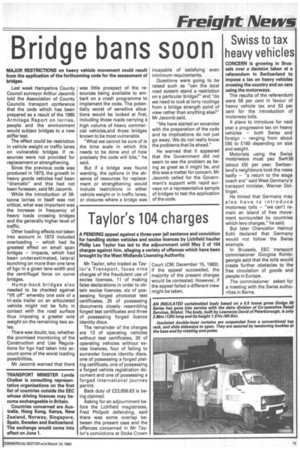Bridge bans soon
Page 19

If you've noticed an error in this article please click here to report it so we can fix it.
MAJOR RESTRICTIONS on heavy vehicle movement could result from the application of the forthcoming code for the assessment of bridges.
Last week Hampshire County Council surveyor Arthur Jacomb told the Association of County Councils transport conference that the code which has been prepared as a result of the 1980 Armitage Report on lorries, people and the environment would subject bridges to a new stiffer test.
The effect could be restriction in vehicle weight or traffic lanes on vulnerable bridges if resources were not provided for replacement or strengthening.
Since the previous code was produced in 1973, the growth in heavy goods vehicles had been "dramatic" and this had not been foreseen, said Mr Jacomb.
While the introduction of 38tonne lorries in itself was not critical, what was important was the increase in frequency of heavy loads crossing bridges and the generally higher level of traffic.
Other loading effects not taken into account in 1973 included overloading — which had its greatest effect on small span bridges — impacts, which had been underestimated, lateral bunching on more than one lane of hgv in a given lane width and the centrifugal force on curve bridges.
Hump-back bridges also needed to be checked against "lift off" whereby one axle of a tri-axle trailer on an articulated vehicle might not be fully in contact with the road surface thus imposing a greater axle weight on the remaining two axles.
There was doubt, too, whether the promised monitoring of the Construction and Use Regulations for hgv had taken into account some of the worst loading possibilities.
Mr Jacomb warned that there was little prospect of the resources being available to embark on a crash programme to implement the code. The potentially worst of sensitive situations would be looked at first, including those roads carrying a high volume of heavy commercial vehicles,and those bridges known to be most vulnerable.
"What we cannot be sure of is the time scale in which this needs to be done and of how precisely the code will bite," he said.
But if a bridge was found wanting, the options in the absence of resources for replacement or strengthening would include restrictions in either vehicle weight or in traffic lanes, or closures where a bridge was incapable of satisfying even minimum requirements.
Questions were going to be raised such as "can the local road system stand a restriction on a particular bridge?" and "do we need to look at lorry routings from a bridge strength point of view rather than anything else?" Mr Jacomb said.
"We have started an excercise with the preparation of the code and its implications do not just go away. We do not really know the problems that lie ahead."
He warned that it appeared that the Government did not seem to see the problem as being as great as it might be, and this was a matter for concern, Mr Jacomb called for the Government's support with rapid surveys on a representative sample of bridges to test the application of the code.




























































































